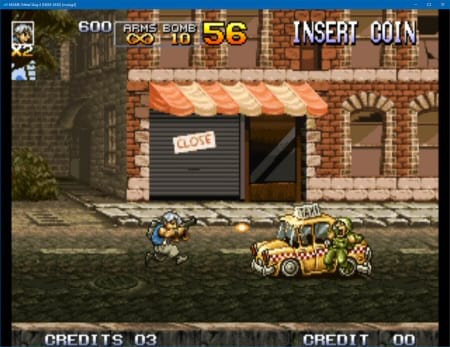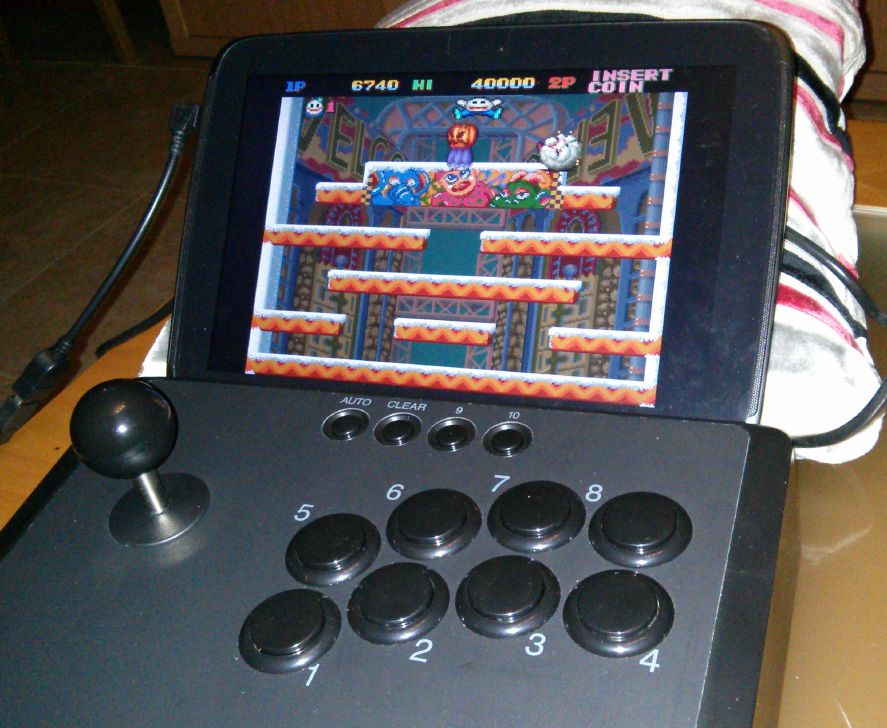
Download Arcade Games Emulator for Android to arcade Games Emulator supported by original MAME 0.37b5 plus some additional games from newer MAME versions. Gamulator is the n.1 place to find and download all the retro roms, iso's and games for your arcade emulator. A cross-platform PSP emulator. PPSSPP is an open source, cross-platform PSP emulator. Since our inception in 2000, we have created open mame arcade cabinets that support popular video game emulators such as MAME. MAME (an acronym of Multiple Arcade Machine Emulator) is a free and open source emulator designed to recreate the hardware of arcade games in software on modern personal computers and other.
God bless emulation and God bless Android devices. MAME serves as something of a cornerstone for retro gaming nostalgics and tends to be the first thing that comes to mind when we feel like reminiscing with classic titles. While its installation and configuration on desktop computers is very straightforward thanks to the number of frontends available, it can be a rather trickier process on smartphones or tablets, particularly if you’re trying to connect a gamepad or external control. Here we’re going to broadly outline how to turn your smartphone or tablet into a small arcade machine. (No, really!)
Software: MAME4Droid
There are two ‘official’ versions of MAME for Android, although it’s actually a port of the iOS version of iMAME4All, MAMED4Droid. (Yes, this is a port of a port; welcome to the world of emulation.) There are two main versions of this program, with the more current one supporting a more modern MAME romset (0.139 compared to 0.37), although it requires a more powerful machine as the emulation is not quite as optimized. Be that as it may, the way both work and are set up is practically identical.
Once one of them is installed, you’ll need to search for the game ROMs, and they must be compatible with the version of MAME you’ve downloaded. The default folder to copy them to your device will be /ROMs/MAME4Droid/, although in most cases you’ll have to restart the device after installing the app for the folder to be generated Stardock multiplicity crack. in your file system. Although it’s possible to copy them directly with an Android file manager, it’s more advisable to connect your phone to a desktop computer by cable and make the changes there.
Once the files are copied and the app is restarted (note that if you just minimize the app it will keep running in the background; you have to specifically select the Exit option), you’ll see the games on the program’s main menu. Careful here, as you need to be faithful to the name the ROMs came with, and obviously don’t unzip the files into the folder, you have to leave them as they are.
MAME4Droid auto-detects your device’s orientation and places the controls differently depending on whether it’s vertical or horizontal, although all this can be modified from the Settings menu. Using the virtual crosspad, select the game you want to launch from the list and press the X button. If when you do so an error message appears saying that files are missing from the ROM, you might have downloaded a bad version, and will have to keep refining your search or testing other download links for the game in question. Obviously, any matters related to the legality of using each ROM falls outside the scope of this post, but experienced gamers should already know what’s up in that department.
Hardware: External control system
Now for the fun part: tinkering. Practically any device that can run Android 4.0 or higher will correctly detect any external peripherals connected via MicroUSB port, Bluetooth, or WiFi. You’ll likely get more play out of the first of those three options, as all you need is a MicroUSB-to-USB adapter to connect all sorts of controllers originally designed for proper consoles. In other words, you can for example connect a USB gamepad for Xbox 360 as we’ve explained in prior posts. But let’s be ambitious here: What if we set up our own arcade machine using a tablet?
There are many arcade joysticks you can connect to your smartphone or tablet on the market, some at very accessible prices. In fact, if you connect one of these, it will be auto-detected by your Android and you can even move around on your home screen and the operating system’s menus using the joystick. That said, for it to work properly on MAME you’ll need to map the controls so you don’t have to touch your screen at any time, allowing you to ‘add coins’ or access the main menu right from the periphery itself.
To do so, you’ll need to go to Option > Settings > Input > Define Keys, where you can configure the controls for up to four players. That done, you’ll have full control over the emulator from your joystick or gamepad. Now you just have to take the next logical step: removing the virtual controls from the screen.
From Option > Settings you’ll see that the settings options are repeated in two sections, one for vertical screen position and another for horizontal. In both cases there is a tickbox called ‘Touch controller visible’, which you can untick to remove any virtual buttons from the screen. Careful, though! If you haven’t mapped the controls yet and you get rid of the screen buttons, you’ll have to work blind to find the Coin, Exit, Option, and Start options.
But there remains an important detail to keep in mind, which is that if you connect the control system to the MiniUSB port, there won’t be any way for you to plug the device into a power supply. The best way to solve this problem is by placing a USB hub between the MicroUSB adaptor and the control itself so that there’s a free port to connect to power. Here’s a short video with the result of connecting a Nexus 10 tablet to a cheap but operative Elecom arcade stick.
Now the crazy part: Your very own arcade machine
As you’ll see in one of the images above, with an arcade stick and a tablet you can set up a small arcade machine at home. But if you’ve gotten this far, nothing’s to stop you from creating your own mini-bartop machine. There are many sites that offer these apparatus at modest prices. Here in Spain, for instance, MataMarcianos.es sells small custom arcade machines that (optionally) house a tablet connected to an arcade stick and buttons.
Even with all that, if you’re brave and handy enough, you can set out to build a physical arcade machine. Once you get to this point, you just have to have a look around the web to find a schematic you like or directly start sketching one yourself. Just like with the aforementioned bartops, how it turns out will depend on how eager you are to dig into the subject: edging the wood, molding the surface of the table glass, or creating vinyls to stick to the surface. A good starting point could be the now-defunct forum at Marcianitos.org, where hundreds of related schematics and tutorials are still stored.
The Android itself will provide the external connectors you need. You can connect speakers to the audio jack to integrate into the machine and get more sound output, although if you want to avoid too much extra noise you could always turn to a pair of USB speakers with an external power supply. The USB hub should help you with this. Likewise, if your tablet has a MicroHDMI jack you can connect a good monitor to put together a proper arcade cabinet, although for those purposes you might be better off finding yourself a Raspberry Pi or directly setting up the arcade machine’s ‘insides’ on a desktop computer. In terms of controls, you can use an arcade stick as the easy route or buy the buttons and lever separately and set yourself to peeling cables. Many use the skeleton of an old USB gamepad to connect without buying a Pac or related gizmo. No one said it was going to be easy!
In any case, MAME is just the tip of the iceberg of everything that can be installed on your Android. We’ve already talked here about RetroArch, an all-in-one that includes most emulators for Android integrated into a single app and accessible via a unified menu system that fits both 8- and 16-bit machines like Nintendo 64 or the first PlayStation, whose performance depends on the power of your device itself. So now that we’ve made it this far… anybody fancy a good session of tinkering?

On February 5, 1997, the Italian Nicola Salmoria developed the first public version of MAME, his Multiple Arcade Machine Emulator that emulates arcade hits via software. He wasn’t the first to do this by a long shot – at the start of the 90s primitive Nintendo emulators began to be distributed – but it’s clear that MAME’s spread was the trampoline from which huge advances in emulation sprang at the turn of the century. Today it’s become the impressive testing ground where you can even find fully functional replicas of current consoles.

Online Arcade Emulator
So what does all this have to do with the Android ecosystem? A lot, actually, as even though there are emulators for almost all machines on PC, your smartphone or tablet is also fully adaptable to your needs and malleable for use in different contexts. Whether you play directly through MAME using its touchscreen controls, gamepads, or a control pad connected to external screens, the emulation experience could be equally possible.
Best Arcade Emulator
¿MAME4All or MAME4Droid?
There are two “official” variants of MAME, both very similar but internally quite divergent and each with different origins. The oldest version, called MAME4droid (0.37b5), is based on the old iMAME4All, an iOS port of the emulator based in turn on the still older MAME3All from GP2X, meaning the ROMset it supports is from quite an old version and includes some 2,000 titles.
The other option is MAME4droid (0.139u1), based on MAME 0.139, and being a more current revision, it accepts a more complete ROMset with support for more than 8,000 ROMs. Plus, since it requires greater hardware specifications, the game runs much more fluidly. Hence we recommend that, unless you use quite a technically outdated Android, you should always opt for the latter version.
How to set up MAME on Android?
Once it’s installed, you have to search for the game ROMs, which must be compatible with the version of MAME you’ve downloaded. The default folder to copy them on your device is /ROMs/MAME4Droid/, though in most cases you’ll have to restart your device after installing the app to generate the folder in your file system. Though it’s possible to copy them directly with an Android file explorer, the most advisable thing to do is to connect the deice by cable to a desktop computer and make the changes from there, especially if you’re going to bust your butt renaming games or manipulating folders with several hundred files.
Arcade Emulator Apk
Once you copy the files and restart the app (careful, as if you minimize it it’ll stay running in the background – you have to explicitly tap the Exit option), you’ll see the games in the program’s main menu. Careful here, as you have to respect the name the ROMs came with, and obviously don’t decompress the ZIP file in the folder – you have to leave it to be detected correctly.
MAME4Droid automatically detects the device orientation and places the controls accordingly, though all these aspects can be modified from the Settings menu. Use the virtual crosspad to select the game to launch from the list and press the X button. If this prompts an error message saying you’re missing ROM files, you might have downloaded the wrong version of the game, so keep refining your search or testing other download links for the game in question. Obviously matters related to the legality of using the ROMs is outside the scope of this post, but make sure you know what you’re doing here.
Hardware: External control system

Now comes the fun bit, the “fiddling.” Practically any device that can run Android 4.0 or higher can correctly detect any external peripheral connected via MicroUSB, Bluetooth, or WiFi. The first of the three options is best for serious gaming, as if you can rustle up a MicroUSB-to-USB adapter you can connect all sorts of control systems designed for use with desktop computers. You can, for example, connect a USB gamepad for Xbox 360 (as we explained how to do here). But suppose you’re even more ambitious and want to set up your own arcade machine using a tablet?
There are tons of arcade joysticks on the market, some of them actually quite cheap, which you can connect to your smartphone or tablet. In fact, if you connect one of them, it will be automatically detected by Android and you can even use it to move around your home screen and system menus. Nonetheless, to run properly on MAME you have to map the controls so you don’t have to touch the screen at any point and can “insert coins” or access the main menu using the joystick itself.
To do this, you have to go into Option > Settings > Input > Define Keys, where you can set up the controls for up to four players. That done, you’ll have full control over the emulator’s physical controls. Now you have just one more step till you’re brand-new control system is ready: remove the virtual controls from the screen.
In Option > Settings you’ll see the setup options repeated into two parts, one for the screen’s vertical position and another for the horizontal position. In both cases there’s an option with a tickbox called “Touch controller visible,” to remove any virtual button from the screen. Careful here! If you still haven’t mapped the controls and you remove the buttons from the screen, you have play blind chicken to find the coin, exit, option, and start options.
But there’s one more important detail to keep in mind here, which is that if you connect the controls to your MiniUSB port, there will be no way to charge the device. The best way to resolve this is by placing a USB hub between the MicroUSB adapter and the controller itself so you’ve got a free port to plug your device into a power source.
Get crazy, ya’ll: Your very own arcade cabinet

As you can see in the images above, with a joystick and a tablet you can set up a small arcade machine for your own house, but if you’ve gotten that far already, there’s nothing to stop you from creating your own mini-Bartop cabinet. There are tons of sites that do this sort of thing at modest prices: here in Spain, for instance, there’s MataMarcianos.es, which sells small custom arcade machines that hold an (optional) tablet connected to a joystick and arcade buttons.
Even with all that, if you’re really handy with a hammer and nails you could take the plunge and build your own arcade machine. Just take a spin around the web to find a schematic you like – or have a go at sketching out your own. As with bigger bartop machines, how well they turn out depends on how much you want to dig into the subject, edging the wood, molding the glass surface of the table, or creating the vinyls to stick to the surface. A good point of departure could be to check out the now-closed forum at Marcianitos.org, where there’s still a backup with hundreds of schematics and tutorials on the subject.
The Android device itself provides you with the external connectors you need. With the audio jack you can plug in speakers to integrate into the cabinet to increase the sound level, though if you want to cut down a bit on extra noise you could always use a pair of USB speakers with an external power source. That’s another advantage of the USB hub. Plus if your tablet has a MicroHDMI outlet you can connect a bigger monitor and really go for the proper arcade cabinet experience (though once you go there it might be more interesting to find a Raspberry Pi or directly install the insides of a desktop computer). In terms of the controls, you can use a joystick as the easy route, or buy the buttons and stick separately and wire in the cables. Lots of people use the skeleton of an old USB gamepad to connect the cables without getting a Pac or something like that. Hey, we never said this would be easy!
In any case, MAME is just the tip of the iceberg in terms of everything emulator-related that you can install on your Android. We’ve talked before about RetroArch, an all-in-one with most Android emulators integrated into a single, accessible app from a unified menu system that covers both 8- and 16-bit machines like Nintendo 64 and the first Playstation, with performance that depends on the power of your own device. So now… who feels like doing some tinkering?
